Key takeaways:
- Gender equality advocacy is driven by personal stories and experiences, highlighting the need for inclusive dialogue.
- Grassroots organizing empowers communities to address local issues, fostering a sense of accountability and collective action.
- Engaging diverse voices enriches advocacy efforts, promoting innovative solutions and deeper understanding.
- Building relationships based on trust and ongoing communication enhances community support and drives effective organizing.
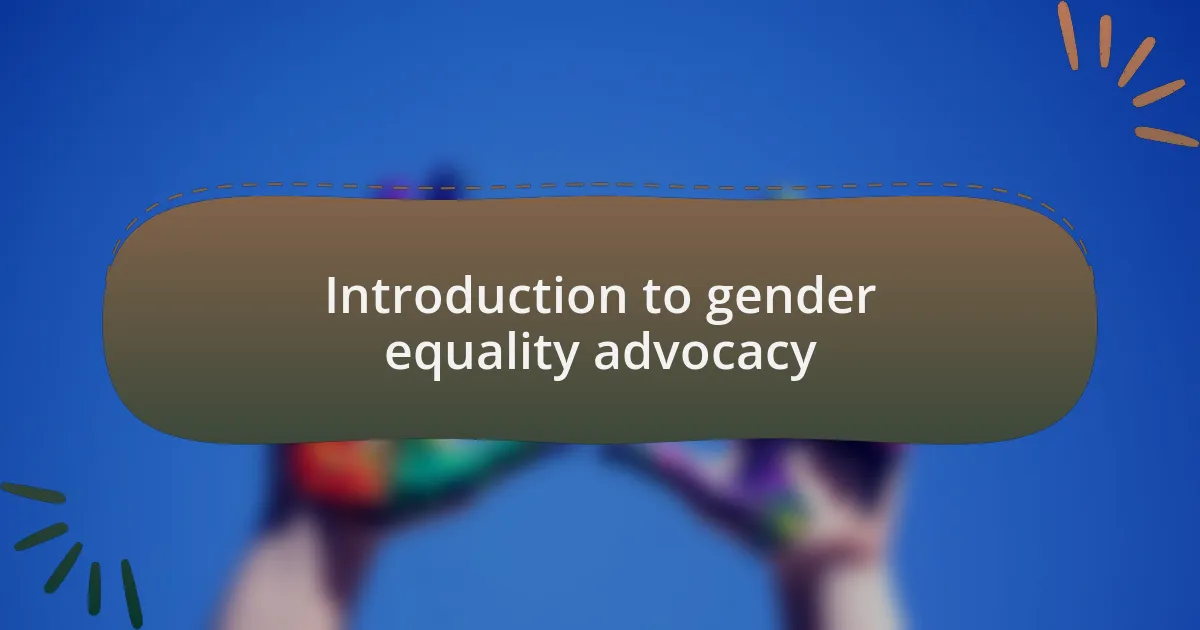
Introduction to gender equality advocacy
Gender equality advocacy is a movement aimed at challenging and dismantling the systemic barriers that inhibit equal opportunities for all genders. I often reflect on the conversations I’ve had with individuals from different backgrounds, where the shared realization of inequality sparked a desire for change. What drives someone to take action? For many, it is the personal stories that resonate most deeply.
Throughout my journey, I’ve witnessed firsthand the impact of gender disparity in various aspects of life—education, employment, and even healthcare are often areas where this imbalance is stark. I remember a discussion with a friend who, despite her qualifications, struggled to be taken seriously in her profession simply because of her gender. Moments like these make it clear that advocating for gender equality isn’t just a collective effort; it’s a deeply personal mission that touches the lives of many.
The essence of gender equality advocacy lies in recognizing that everyone benefits from a more equitable society. Have you ever considered how much potential is untapped simply because someone feels marginalized? It’s crucial that we not only amplify these voices but also actively work towards creating spaces where everyone can thrive, as I have seen the transformative power of inclusion and opportunity in my own experiences.
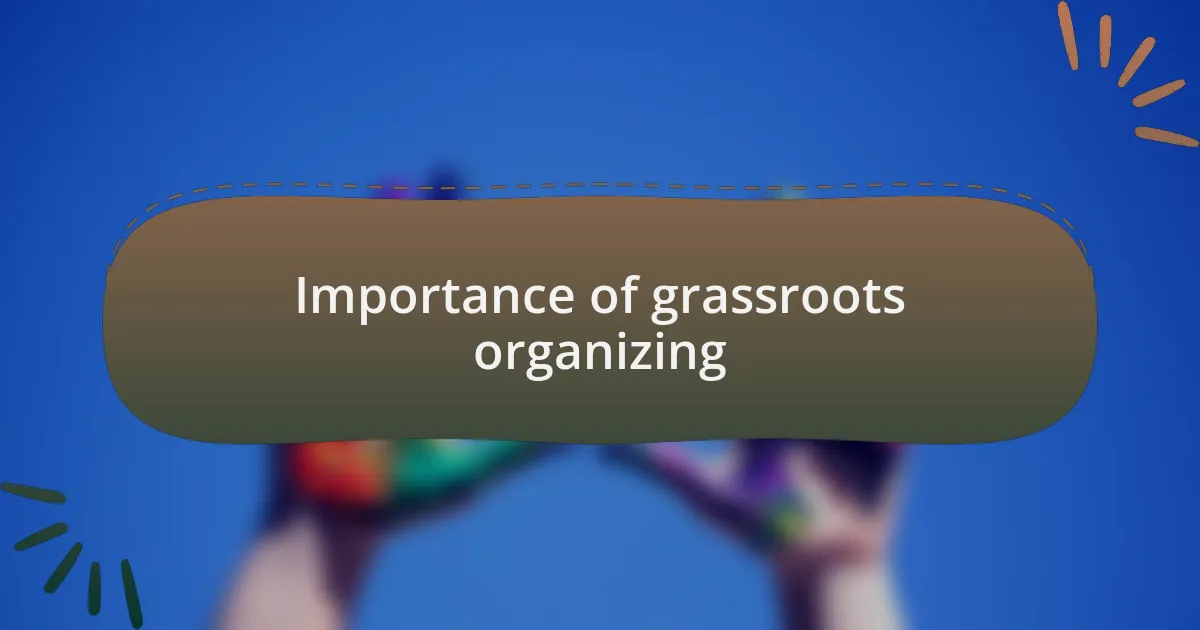
Importance of grassroots organizing
Grassroots organizing is essential because it empowers individuals within communities to rally around common concerns. I can recall a time when a small group of us gathered in our local park to discuss the lack of support for survivors of domestic violence. As we shared our stories, the depth of our shared experiences lit a spark that nobody expected, turning our collective frustration into a powerful movement for change. This illustrates the potential grassroots organizing has to transform personal stories into a unified voice advocating for justice.
Moreover, grassroots efforts often hold the key to real, sustainable change as they tap into local knowledge and resources. I remember volunteering for a community organization that aimed to secure equal pay for women in our city. The passion and insights of the women I met inspired me to see how local initiatives can create ripples of change, affecting policies at higher levels. When communities take ownership of their issues, it fosters a sense of accountability and commitment that larger organizations sometimes overlook.
Let’s not forget the significance of building networks of support through grassroots organizing. Have you ever felt isolated in your advocacy efforts? I certainly have, but through grassroots connections, I found solidarity. Those shared moments of struggle and triumph highlight how effectively organized communities can counteract the broader structures of inequality. It’s about harnessing our collective voices to make a larger impact, and I believe that every small effort contributes to a greater movement towards gender equality.
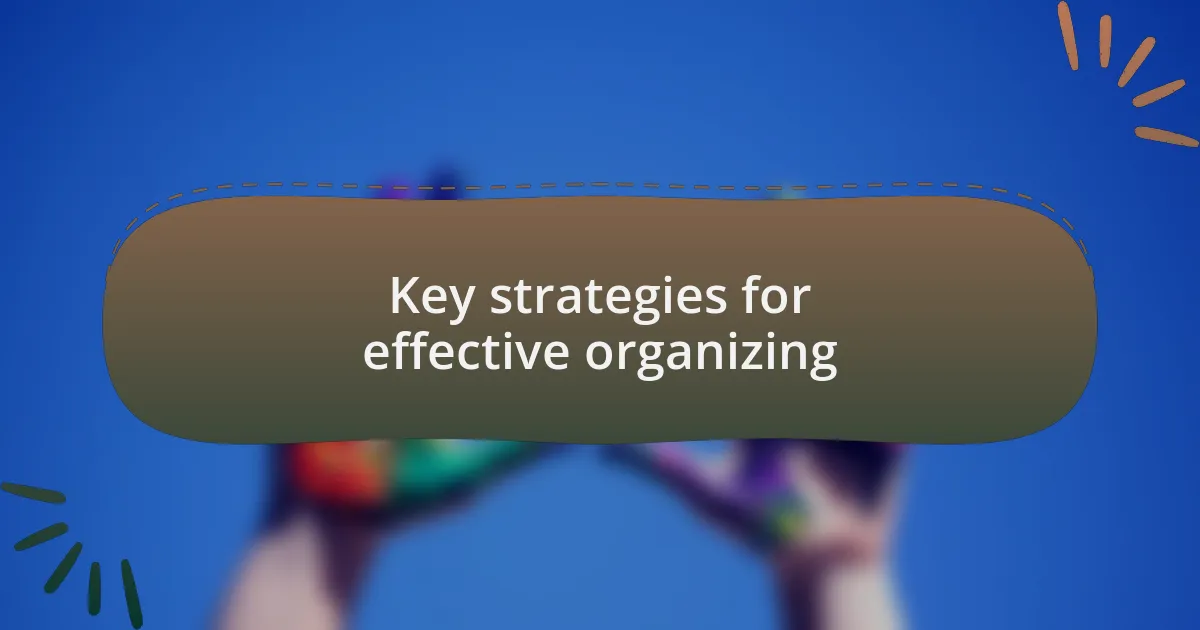
Key strategies for effective organizing
One key strategy for effective organizing is fostering deep relationships within the community. I experienced this firsthand when I started attending local town hall meetings. Initially, I felt like an outsider, but as I began to engage with others—sharing meals, laughter, and even our struggles—a sense of belonging often arose. This camaraderie not only helped build trust but also transformed us into a cohesive unit working towards our shared goals.
Another crucial strategy is centering the voices of those directly impacted by the issues at hand. I remember collaborating with a group of women affected by housing instability; listening to their stories was both enlightening and humbling. It was eye-opening to realize that true advocacy doesn’t come from assumptions but from amplifying lived experiences. Have you ever noticed how powerful a personal story can be in swaying opinions? I truly believe that when we prioritize these narratives, our organizing efforts become more relatable and impactful.
Additionally, leveraging social media for outreach and engagement cannot be overlooked. I once coordinated a campaign on a shoestring budget, mainly using social platforms to spread the word about our cause. The responses were immediate and heartfelt; it was incredible to see how a simple post could galvanize support from individuals who had never met us. In today’s digital world, it’s thrilling to think of how far our messages can travel. Are we utilizing these tools to their fullest potential? By combining traditional organizing methods with innovative online strategies, we can definitely reach wider audiences and foster greater change.
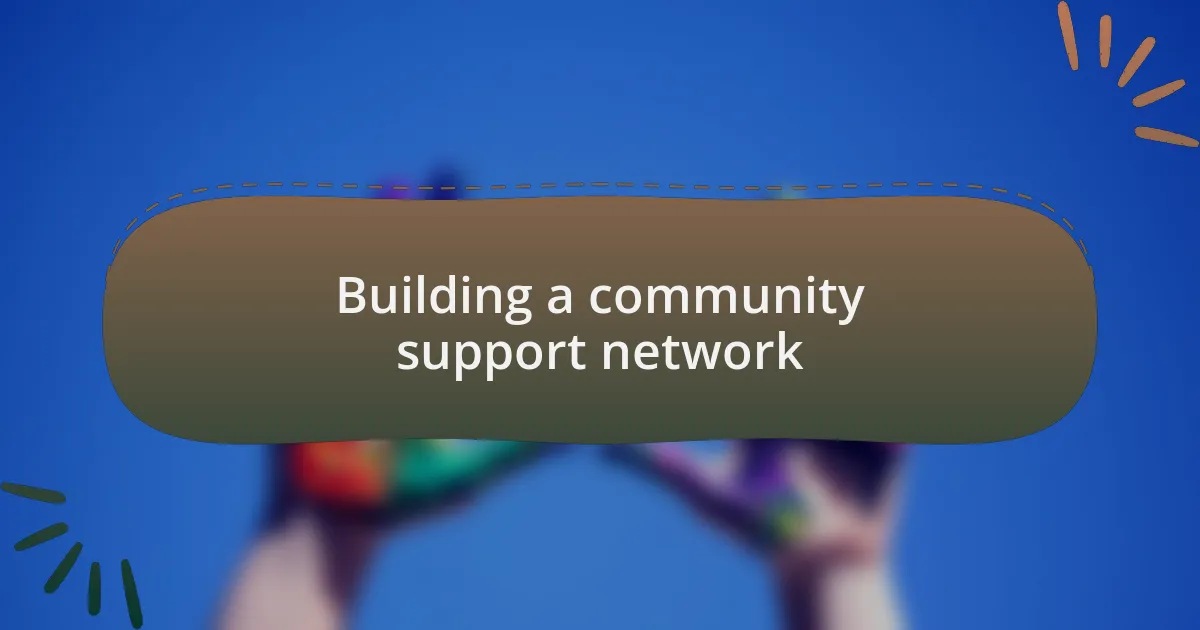
Building a community support network
Building a community support network starts with identifying shared values and common goals. I recall a time when I hosted a small gathering for neighbors to discuss our vision for a more inclusive community. The atmosphere was both nervous and excited, but as we shared our aspirations, I could feel the energy shifting. It was in that room, filled with diverse voices and experiences, that the seeds of collaboration were sown.
Another important aspect is nurturing those relationships over time. I remember a particularly busy week when I made it a point to check in with community members, even if it was just a quick message or a cup of coffee. These small gestures made a big impact; suddenly, it wasn’t just about organizing events but about creating a support system where everyone felt valued and heard. How often do we overlook the power of a simple, caring check-in? It’s remarkable how these connections can lead to collective resilience when challenges arise.
Moreover, I’ve found that having a shared platform for continuous communication greatly enhances our network’s strength. In my experience, we created a WhatsApp group where anyone could voice concerns, share resources, or celebrate successes. It transformed our interactions from surface-level engagement to deeper, ongoing conversations that empowered individuals and strengthened our community as a whole. Can you imagine the potential when everyone has a voice? It fosters not just support, but a sense of unity in pursuing gender equality.
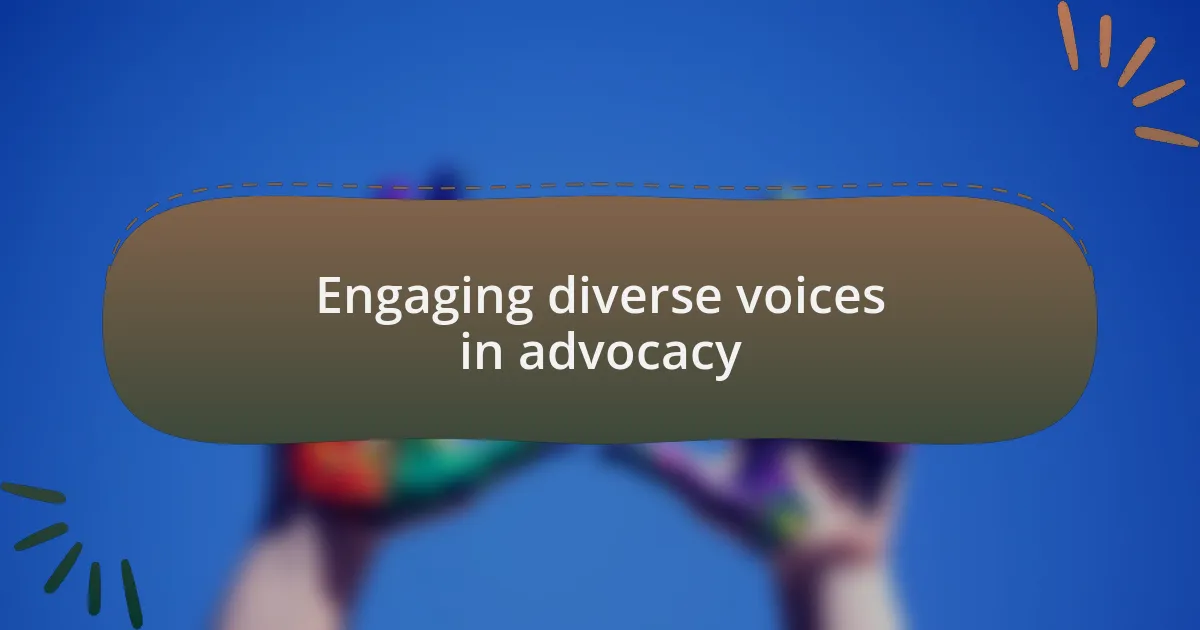
Engaging diverse voices in advocacy
Engaging diverse voices in advocacy is about recognizing the unique perspectives each individual brings to the table. I remember hosting a panel discussion where participants hailed from various backgrounds—different genders, ethnicities, and life experiences. As we opened the floor for discussion, I noticed how a single question could spark powerful insights that I had never considered before. It truly reinforced the idea that when we uplift diverse voices, we enrich our advocacy efforts in a way that benefits everyone.
When we actively listen to and incorporate diverse viewpoints, the advocacy landscape shifts dramatically. I once facilitated a workshop aimed at strategizing our approach to community outreach. The ideas shared ranged from grassroots initiatives to policies that mirrored lived experiences. I was struck by the passion and knowledge of attendees who often felt their voices had been marginalized. Is it possible that we sometimes overlook the wealth of knowledge right in front of us? By creating safe spaces for dialogue, we not only validate these experiences but also cultivate innovative solutions that address our collective goals.
Furthermore, I believe that showcasing stories of individuals from diverse communities can be incredibly powerful. During a local event, we invited community members to share their journeys related to gender equality. I watched as their stories resonated with the audience, bridging gaps and fostering empathy. Isn’t it amazing how personal narratives can inspire action? By amplifying these diverse voices, we promote a deeper understanding and commitment to advocacy that goes beyond mere statistics and policy—it’s rooted in humanity itself.
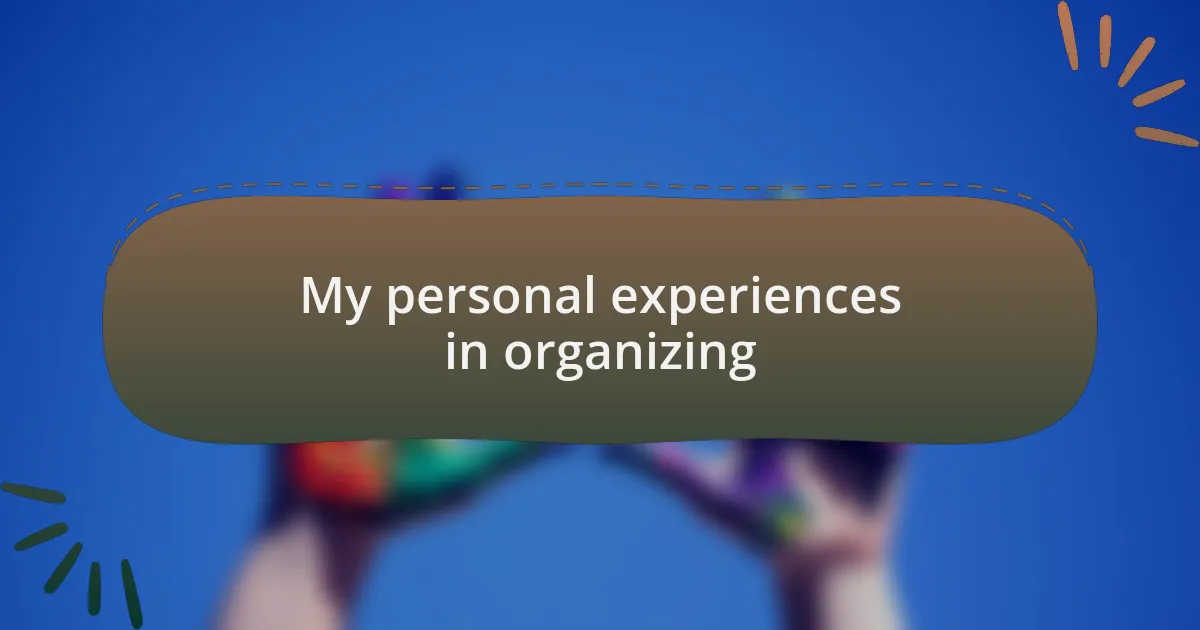
My personal experiences in organizing
Organizing events has not only been about logistics for me; it’s also been deeply transformative. I recall a time when I coordinated a community forum aimed at addressing gender-based violence. As I watched attendees share their stories, I felt an overwhelming mix of sadness and hope. Their vulnerability allowed for connections that I somehow knew transcended the room. Wasn’t it eye-opening to witness how shared experiences could turn strangers into allies?
One of my most poignant moments in organizing occurred during a campaign to promote equal pay. I was nervous standing in front of a diverse group of individuals, many of whom had faced discrimination firsthand. When I opened the floor for sharing, I was met with a myriad of perspectives that challenged my understanding of the issue. Why had I not realized how widespread and nuanced the problem was? It was a vivid reminder that the richness of advocacy lies in listening, understanding, and amplifying those truths.
I’ve learned that true organizing is about building relationships rooted in trust and understanding. During a recent project, we gathered in small circles to discuss personal barriers to participation in leadership roles. The emotional weight of those conversations struck me, as participants became more animated when discussing their shared struggles. In that moment, it dawned on me how vital it is to create spaces where authenticity thrives. How often do we consider how our personal stories can ignite collective action? Engaging with these narratives is, to me, the heart of effective organizing.

Lessons learned and future goals
Through my journey in grassroots organizing, I’ve realized that every setback carries a lesson. I distinctly remember a campaign that didn’t yield the expected turnout. Initially, I felt disappointed, but as I reflected, I learned that meaningful discussions often occur in smaller, more intimate settings. Isn’t it fascinating how sometimes less is more? That experience taught me to adapt my strategies and seek quality over quantity in engagement.
Looking toward the future, I’m committed to integrating more innovative approaches into my organizing efforts. The world is evolving rapidly, and so should our tactics. For example, I envision utilizing digital platforms to connect with younger advocates in ways that feel authentic to them. What new avenues can we explore to make our message resonate across generations? That question drives me as I consider how to inspire the next wave of gender equality advocates.
Ultimately, my goal is to foster a culture of support and empowerment. I want to ensure that every voice is heard, especially those that have historically been marginalized. Creating mentorship programs that connect seasoned organizers with newcomers seems vital. How else can we cultivate an environment where every participant feels valued? It’s those connections that will strengthen our movement moving forward.